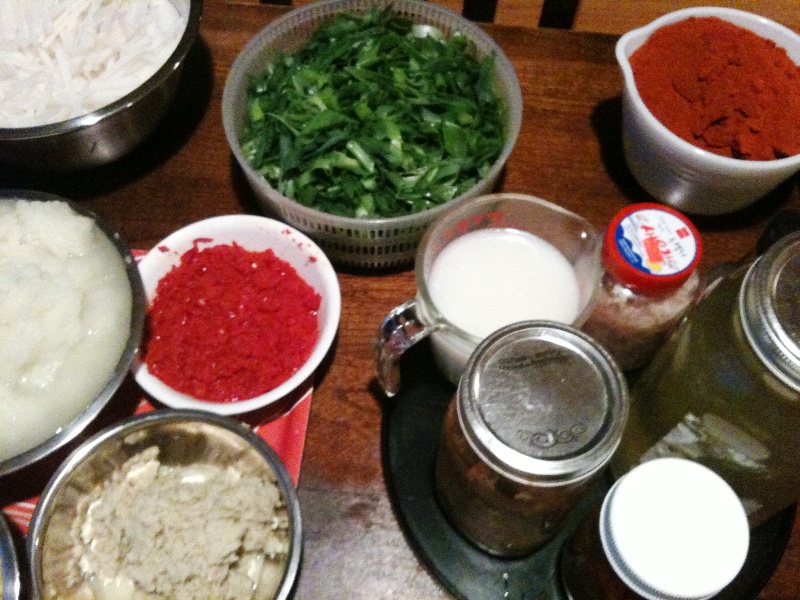10 Nov / How to Host a Kimchi-Making Party

A couple of years ago, my friends Philip and June Lee invited me to a kimchi-making party. (An aside: Philip and June helm Readers to Eaters, a cool organization that’s part indie publisher, part pop-up bookstore and part food literacy educator.)
Traditionally, kimchi is made during the fall in Korea. Fall is harvest time and kimjang, the cabbage harvest, is always followed by kimchi-making. Think of it as the American equivalent of canning summer fruits and vegetables.
Before refrigeration, making kimchi was the only way to preserve harvest vegetables and their nutrients for the long, frigid Korean winters.
Even though Chinese/napa cabbage (baechu), the most common kimchi-ed vegetable, is now grown year-round, kimjang is still an annual rite in Korea marking fall’s transition into winter. Besides, nothing beats the voluptuous heads of cabbage that swell and sweeten with the chill of fall.
Kimchi-making has always been a communal activity so having a kimchi party is a great way to gather friends for a fun pre-holiday activity.
I can’t give you exact measurements—how much of each ingredient you have will depend on the number of people you invite. However, here’s a list of ingredients the Lees had at their kimchi party.
When making the kimchi, don’t worry about getting the “recipe” right. Tell your guests to trust their tastebuds and taste as they go, and just have fun!
Ask your guests to bring vegetables to contribute to the pot and equipment: knives, chopping boards, big bowls, colanders, and containers to bring the kimchi home. Mason jars or old jam/jelly jars work well. Or double-bag in zip-top bags.
~~~
Kimchi-Making Party How-To
Ingredients:
- Dried Korean red pepper flakes (gochugaru)
While chili peppers are ubiquitous in Korean cuisine today, they were only introduced in the 17th century. They did wonders to enhance the flavor of kimchi! Plus, the capsaicin compound that makes it spicy promotes long term fermentation. Look for bright red coarse ground red pepper flakes.
- Aromatics
Fresh garlic, ginger, and onions amplify the spice notes. Grind them each separately in a food processor.
- Fermented seafood products
In the south where it is warmer and seafood is more common, seasonings like fermented anchovy sauce (jeotgal) and salted shrimp (saeujot) are used to create layered, complex flavors. They were important as building blocks of flavor before chilies were introduced. Use Thai or Vietnamese fish sauce and/or salted dried shrimp if you can’t find Korean versions.
- Meat broths (optional, refer to The Kimchi Cookbook by Lauryn Chun )
In the north, the climate is cooler and seafood harder to come by so meat broths like beef or sometimes mushroom broth are used as seasonings.
- Sweet rice flour porridge (optional, refer to The Kimchi Cookbook by Lauryn Chun)
Sweet rice flour is cooked with water and used to bind the seasoning paste and make it more viscous. It also helps offset bitterness of certain vegetables.
- Vegetables
Chinese/napa cabbage, savoy cabbage, cucumbers, carrots, daikon, radish, turnips, kale, spinach, green onions, Asian pears, apples–practically any vegetable or fruit can be turned into kimchi.
- Coarse sea salt
Salt draws out moisture from the vegetables to make them crunchy. Salting also opens up the vegetables’ “pores” so that the seasonings are easily absorbed and allows the vegetables to ferment more evenly. Kosher salt will also work though sea salt has a pleasant briny taste.
- Sugar
You might want some on hand if your guests want to add a little sweetness and/or to lighten up the spice.
Method:
- Start with a mass chopping session. Chop/cut/shred the vegetables into bite sized pieces—squares/rectangles (cabbages), chunks (radish, daikon), julienned/matchsticks (carrots), shreds (kale, collard greens), etc.
- Sprinkle salt over the vegetables (about 1 tablespoon per pound) and leave for about an hour or as long as you can wait. When beads of “sweat” start appearing, that’s a good sign. Rinse excess salt and allow to drain in a colander over the sink. Don’t bother salting shredded or julienned vegetable, or green onions.
- Lay all the ingredients out on the table.
- Give everyone a pair of gloves and a large metal/non-reactive bowl.
- Make the seasoning paste first:
Blend chili pepper flakes, ginger, garlic, onions, fermented seafood products, meat broth and/or sweet rice flour porridge in your bowl. Taste and adjust seasonings as needed.
- Add shredded vegetables first and mix well with your hands, followed by chunkier vegetables. Mix well.
- Pack the vegetables into jars, leaving an inch or two at the top for expansion when fermentation occurs so that it doesn’t overflow.
- At home, keep the kimchi at room temp for one to three days. Once you see bubbles forming proper fermentation is occurring. Taste every day until the kimchi is to your taste. Under-fermented kimchi may be bitter or sour and give off a foul odor before turning into tangy, delicious vegetables. Then refrigerate for long term storage and fermentation. Or refrigerate immediately and wait one to two weeks minimum.
Note: If you’d likea “recipe,” refer to Kimchi-style Corn or Cabbage Kimchi. The Kimchi Cookbook: 60 Tranditional and Modern Ways to Make and Eat Kimchi by Lauryn Chun is also an excellent guide to kimchi-making.










